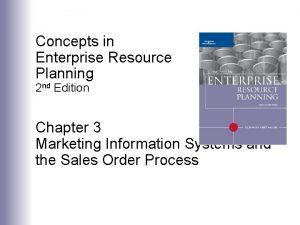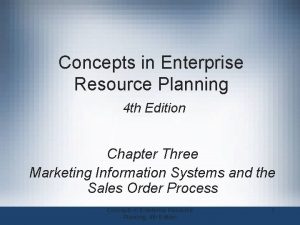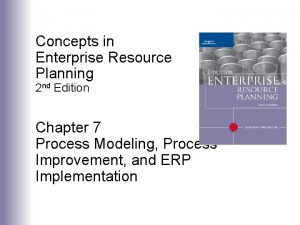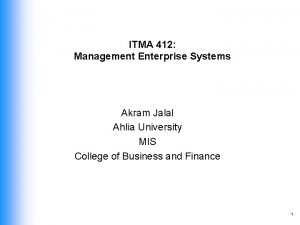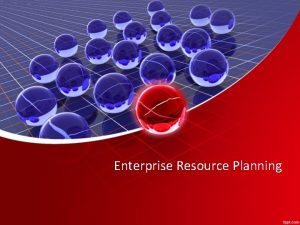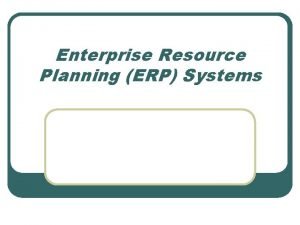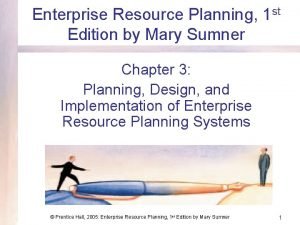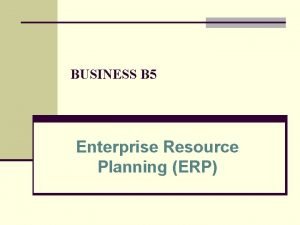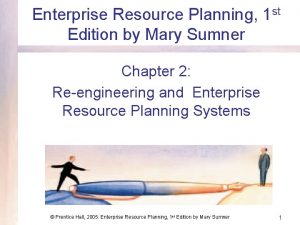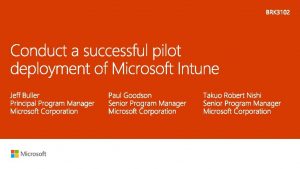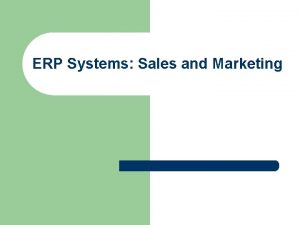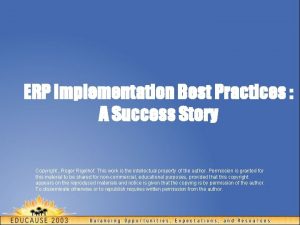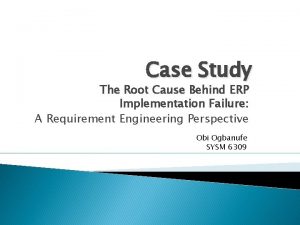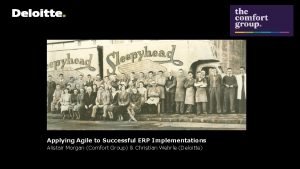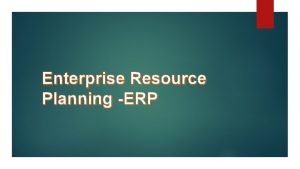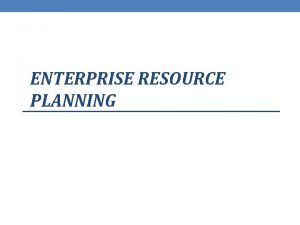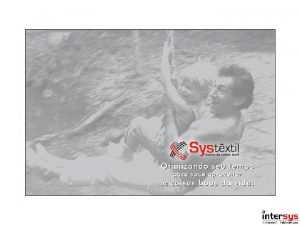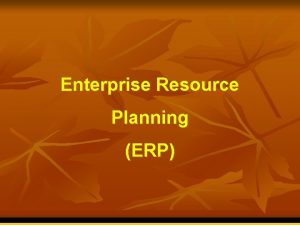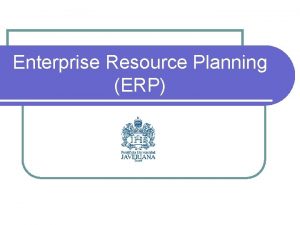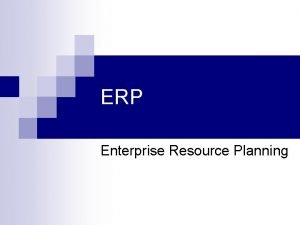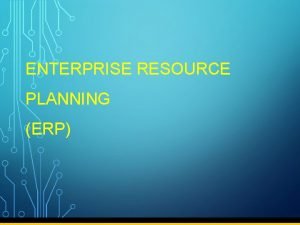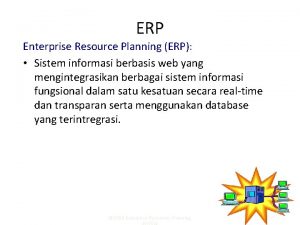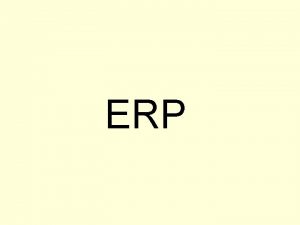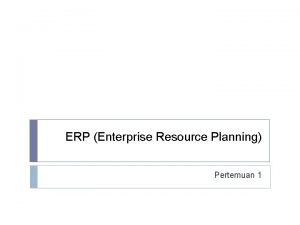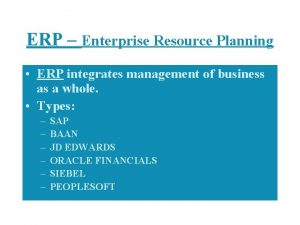Enterprise Resource Planning Design Implementation ERP Installation Concepts


















- Slides: 18

Enterprise Resource Planning, Design, & Implementation ERP Installation Concepts Instructor: Richard W. Vawter University of Southern California

Topics l Terms and Definitions l ERP Configurations l General Installation Concept University of Southern California

General Terms l Host - The host computer (server) provides a centralized storage area for programs, data, and information on a network. l Host name - the name of the server upon which your centralized applications and data are stored (e. g. K 1). l Domain - A group of servers on a network which share common applications, data, and user authorizations (e. g. the ITP domain). l Client - A computer on the network that relies on servers for resources such as files and data (e. g. the lab computers). l GUI - (Graphical User Interface) Software which is loaded on a computer to provide a user friendly interface to applications and data stored on the network server. (aka Frontend software) University of Southern California

General Terms (cont. ) l RAM - (random access memory) Memory chips that can be read from, and written to, quickly, by the computers processor. l Virtual memory - A portion of your hard drive storage which you allocate for the computer’s operating system to use as additional RAM. (aka Paging memory) l RAID - (Redundant Array of Independent Disks) An array of two or more integrated hard disks used to store large amounts of data and ensure data reliability by duplicating the data. n RAID 1 - Mirroring. Has one back-up disk for each disk. n RAID 5 - Striping. Splits data and instructions across multiple disks improving disk access time but not offering data duplication. Both methods enable “hot swapping” of failed disks. University of Southern California

Topics l Terms and Definitions l ERP Configurations l General Installation Concept University of Southern California

The Three-Tier Computer Hierarchy Central Database (Storage of all data) Access to Database: (Read / Write data) Database Layer Input / Output of data to users Application Layer Presentation Layer Processing of data using application logic Presentation of the processed data to the user University of Southern California

Types of ERP Installations l In the Central System, the ERP instance and the database instance are on the same host machine. Database Instance (data storage) ERP Instance (App. logic) Client Host Frontend software (GUI) University of Southern California

Types of ERP Installations (cont. ) l In the Distributed System (stand-alone database system), the ERP instance and the database instance are on different host machines. Database Instance (data storage) Host Central Instance (App. logic) Frontend software (GUI) Host Client Dialog Instance (App. logic) Host Additional Dialog Instances may be req. for load balancing Client

Data Flow and Processing w/in an ERP System Data base Relational data base system 4 5 Application Roll Work Process 3 Page 6 SAP Memory Buffer 2 Dispatcher Request queues 7 Presentation 1 Terminal Process SAP GUI University of Southern California

Processing w/in an ERP System (cont. ) l The Dispatcher distributes the request from the user (via the frontend GUI) to the appropriate work process. n Dialog work process n Background work process n Update work process n Spooling work process The Enqueue work process maintains that no two users can modify the same data at the same time. l The work process then processes the data from the database and returns the results to the dispatcher. l The dispatcher then forwards the results to the user via the frontend GUI. A message work process (sometimes on its own server) handles communication between hosts of similar ERP systems. Gateways handle communication between dissimilar ERP systems (e. g. ERP systems between companies). University of Southern California

An ERP instance. . . l May be thought of as an application containing many components grouped together that offer one or more services or processes. l The services offered by an instance are started or stopped all together. University of Southern California

Technical Configuration for a Company’s ERP Strategy Development Testing Database Servers Application Servers Presentation Servers Production

Topics l Terms and Definitions l ERP Configurations l General Installation Concept University of Southern California

General Installation l The task of installing an ERP system can be subdivided into 4 phases: Planning Preparations ERP System Installation Post-Installation Activities University of Southern California

The Planning Phase l Check hardware and software requirements n Decide upon the optimal configuration for your system (e. g. central vs. distributive system). n Decide whether a domain or local installation is suitable. n Verify your system meets the ERP hardware requirements. l Work out how the main system directories and physical storage are to be distributed to your systems disk’s RAID arrays. n Consider size of components. n Consider security requirements. University of Southern California

The Preparation Phase l Prepare (set-up) the operating system on all hosts that will be used with the ERP system. For example, on a Win. NT: n Use NTFS file storage n Latest Service Pack n Host belongs to a domain n Adjust virtual memory n Latest version of. dll libraries n Maximize throughput for network applications. l Perform some preparatory tasks for the ERP system prior to actual software installation. This may include: n Choose ERP system names. n Set-up transport hosts. n Prepare special printing configurations. University of Southern California

ERP System Installation Phase l Load the software based upon the criteria determined during the planning stage. (e. g. central vs distributed) l Software must be loaded for all layers: n Database layer (Db software) n Application layer (ERP software) n Presentation layer (Frontend GUI) l Order of software installation is generally: 1. Load Db software 2. Create ERP instance 3. Create Db instance (build the database) 4. Populate the Db tables University of Southern California

The Post-Installation Phase l There are several activities which will always need to be performed in this last phase: n Starting and stopping the systems n Logging on to the system n Checking primary ERP services n Licensing the system n Installing online documentation n Setting up administrative accounts n Backing up the system University of Southern California
 Concepts in enterprise resource planning
Concepts in enterprise resource planning Concepts in enterprise resource planning
Concepts in enterprise resource planning Concepts in enterprise resource planning
Concepts in enterprise resource planning Enterprise resource planning example
Enterprise resource planning example Enterprise resource planning example
Enterprise resource planning example Enterprise resourse planning systems
Enterprise resourse planning systems Cayenta mobile workforce management
Cayenta mobile workforce management Sistema erp adalah
Sistema erp adalah Pengertian erp system
Pengertian erp system Enterprise resource planning mary sumner
Enterprise resource planning mary sumner Extended enterprise resource planning
Extended enterprise resource planning Contemporary management ppt
Contemporary management ppt Enterprise resource planning mary sumner
Enterprise resource planning mary sumner Sap lieferplan kopierer sd
Sap lieferplan kopierer sd Intune deployment project plan
Intune deployment project plan Modulos erp
Modulos erp Best practice erp implementation
Best practice erp implementation Erp implementation failure a case study
Erp implementation failure a case study Applying agile approach in erp implementation
Applying agile approach in erp implementation
